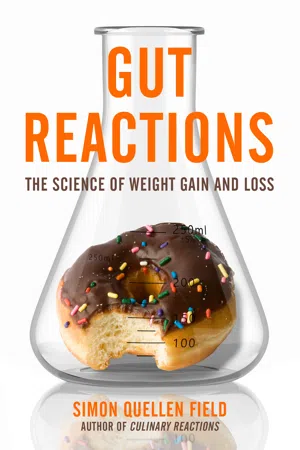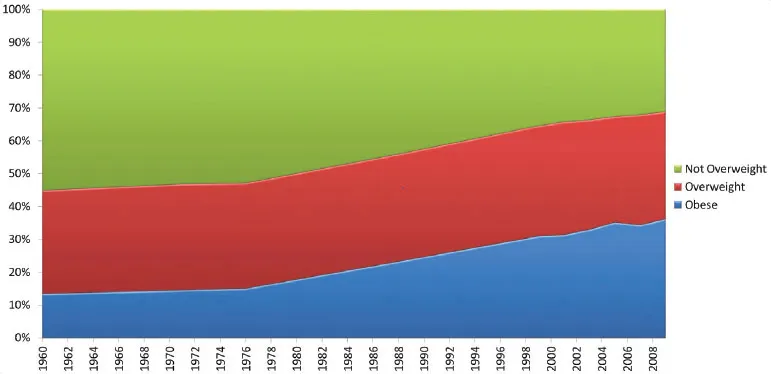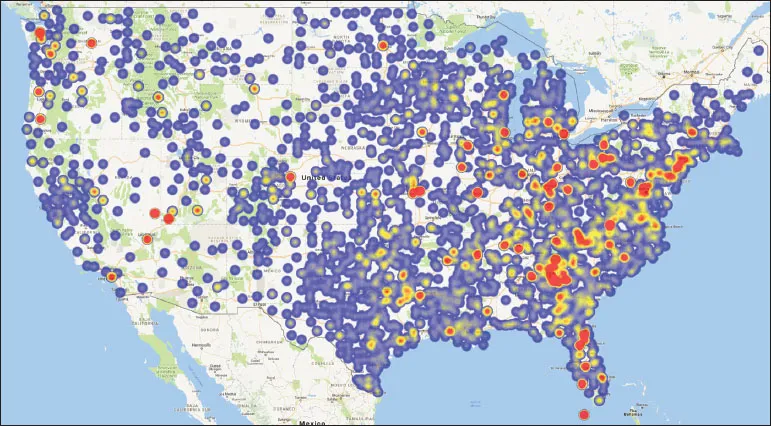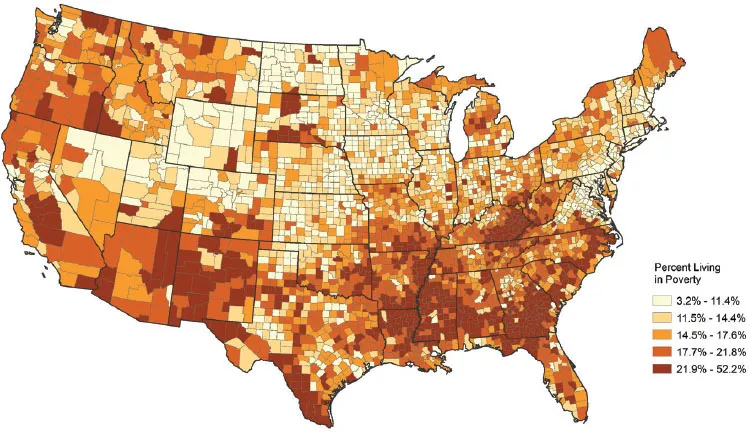![]()
1
INTRODUCTION
Walk past the diet section in a bookstore and you will find hundreds of books that each claim to have the solution to weight problems. Whether it’s a low-fat diet, a low-carbohydrate diet, a Paleolithic diet, a gluten-free diet, or any number of other magical things to try, they all claim that your problem is simple and has a simple solution.
The popularity of these diets is linked to the observation that they all seem to work. Why would these different approaches to weight control all have success? One reason is that they all limit your choices. When you are not able to eat everything in sight, you tend to eat less. Another reason is that each diet targets a different set of people and works for that set, if not for others.
Of course, they all work until they don’t. Limiting your diet in this way is difficult to do for long periods of time.
There aren’t many things that we expect to work for all people all the time. People are different from one another. There are genetic differences, cultural differences, behavioral differences, psychological differences, and social differences, and they all play a part in the weight maintenance equation. Add to these differences age, gender, gut microbiology, and environment and it becomes clear that weight control is a personal thing, and the solutions might have to change not only with each individual, but also with time and setting.
Obesity is not one disease. There are many subtypes of obesity. Some people will have disorders in how their bodies manage energy balance, while others may have differences in how they respond to reward, making it hard for them to resist highly palatable foods. There are many ways to affect our body composition toward more fat, and that is what this book is about.
HOMEOSTASIS
Homeostasis is the word used for the body’s automatic system for weight control. Homeostasis means “staying the same” (from the Greek words for “similar” and “standing still”). It is very important for the survival of any organism. Without it, the animal starves to death, or feeds to death. Biological systems that are this important have many components, with several checks and balances, and interactions with other systems. Things get complicated.
There are two kinds of weight problems that are related to homeostasis.
Some people slowly gain weight all their life. A weight gain of a single pound a year adds up over time, and by age 40 or 50, those 20 to 30 pounds of extra weight are noticeable in the mirror, on the scale, and in the doctor’s office.
Other people find that they reach a particular weight and stay there, in homeostasis, but at a weight that is unhealthy or otherwise undesired.
In the first case, homeostasis isn’t working properly. In the second case, the controls are set higher than we’d like, and we want to change them.
We keep many of our body systems in homeostasis. We regulate our temperature—we can die if we get too hot or too cold. We regulate our blood pressure and our blood sugar. Again, we can die if either gets too high or too low. Problems with blood sugar homeostasis cause diabetes. It turns out that all these other control systems interact with the control systems for body fat. Disease and fat can be correlated. Obesity is a risk factor for diabetes, and raising the body temperature during a fever burns fat.
HISTORY
As I write this, over 68 percent of adult Americans are overweight, and over 35 percent are obese. We know this isn’t just a little bit of weight gain over many years because 32 percent of children and teenagers are overweight, and 17 percent are obese. They haven’t had time to accumulate their fat slowly. But since obesity rates do go up with age, some part of the problem is small increases over time.
If these numbers had always been the same, we wouldn’t worry. We don’t worry about obese elephant seals or hippos. Their fat percentages are normal for their species and are essential for their survival. But humans have been gaining weight since the 1960s. While the percentage of people who are overweight but not obese has remained fairly stable, the percentage of obese people has risen from about 13 percent in the 1960s to over 35 percent today (Ogden and Carroll 2010).
Something happened between 1980 and now. The sharp corners in the graph above are an artifact caused by the fact that the data comes from surveys done at particular times. Nonetheless, the overall trend is real. What changed in those years that caused the rise? What has caused the rates to stabilize since 2010? We will look into those questions in the following pages.
The fact that obesity rates changed in the late 1970s, and then stabilized in the 2000s, is actually good news. It means that obesity rates can change. What was done can be undone. In fact, the recent stabilization in growth is likely due to new scientific knowledge about fat homeostasis, and as we make that information more widely available, there is hope that obesity rates may fall as quickly as they rose.
In preindustrial America (before 1900), the obesity rate hovered around 4 percent, compared to 35 percent today.
Some of the changes in the American diet since that time are related to the diversity of the foods available and the ease of preparing food. Before supermarkets, kitchen stoves, refrigerators, restaurants, fast food, and frozen dinners, the variety of foods available was limited. Limiting choice in food is a form of dieting. Food becomes less interesting, and we eat when we are hungry, rather than when we are tempted.
Another change in diet was the rise in consumption of polyunsaturated seed oils, rich in omega-6 fatty acids. We are eating three times the amount of polyunsaturated oil as we were before 1900. Also striking is our doubling of sugar consumption in that period. Consumption of sweetened beverages is five times what it was in 1900.
Our food technology has also allowed manufacturers to improve the palatability of our food, at the same time they improve the appearance, shelf life, and manufacturing efficiencies. Since 1970, Americans have increased the amount eaten per day by 425 calories, a full 20 percent, which may be due to a combination of a wide variety of foods available, the high palatability of those foods, the ease of eating them at a restaurant or out of the microwave, and other factors we have not (yet) discussed.
If we are eating 20 percent more food than we were 45 years ago, is that where all the fat is coming from? Not necessarily. The natural homeostasis systems in our body would normally do something with that food other than store it as fat. We would increase our metabolic rate and our level of activity. The fat cells would produce signals that tell us we are full. Our stomach would stop producing hunger signals. Whether this is enough to overcome the temptation of eating all that delicious food that is sitting right there in front of us is something we will explore further later.
If we eat 20 percent more food than we need, and it goes into making new fat cells, those cells will need food to survive. If we gain weight, we will need more food just to move all that weight around all day. We can’t just say that adding 425 calories per day adds some fixed amount of fat every day. We should expect that the amount of added fat would decrease over time. The same math works in reverse. Dieting should eventually lead to a plateau in weight, as the lost calories will eventually lead to a lower metabolic rate and less activity, accompanied by an increase in hunger signals that causes you to cheat on the diet.
The amount of exercise people got in the early 1900s (when the obesity rate was 4 percent) is also likely more than what the average American is getting today. Transportation back then involved more walking. Work involved more moving around than the typical desk job does today. Entertainment did not involve sitting in front of a screen at home. While these differences in the way society works and plays are not likely to change, individuals can choose to get more exercise, and we have tools today that can monitor the number of steps we take and remind us to get up and walk around. I would not, however, expect that exercise is the answer to weight loss. We burn nearly all our calories just staying warm, pumping blood, and thinking. If you were to go running for an hour a day, the extra calories you burn would be at most about 20 percent of your daily calories. Then homeostasis would kick in, and you would relax for the rest of the day to make those calories up.
We are also getting less sleep than people used to get. Sleep is important for regulating metabolism, and lack of sleep makes us hungry in two different ways, which makes us eat more. (More on this later.) Sleep can be disturbed as we fool our diurnal clocks by using artificial lighting and watching television, computers, or cellphone screens late into the night. In particular, getting blue light after sunset can cause sleep abnormalities, and there is a lot of blue light in our various electronic media—you can’t make white pixels on a screen without blue.
Where you live can make a difference in your diet and the amount of exercise you get. At the top of the next page is a “heat map” of US counties, colored by the percentage of obese people in the population.
There are clearly “hot spots” in the distribution. This is unlikely to be due solely to genetics, as people in the United States have a high degree of mobility and a diverse population. Likewise, cuisine does not vary enough to account for the distribution. There is a very good national food distribution system, and supermarkets across the country carry much the same kind of food.
What does seem to correlate to a good extent is poverty. The United States subsidizes crops like corn, wheat, and sugar, and these high-carbohydrate foods are easy to process into cheap addictive products with long shelf lives, easy transportation and storage, and lots of marketing.
In contrast, fresh fruits and vegetables are not easy to find in poor neighborhoods, and animal protein sources are expensive. Education about diet is also an issue in areas with low education levels or where language barriers exist. Compare the locations of obese counties in the heat map to the high-poverty counties in the map on the bottom of the previous page.
We see the same trends with other addictive substances, such as alcohol, tobacco, and recreational drugs.
EATING FOR REWARD
Two changes in lifestyle have also contributed to the obesity problem. We have become very good at designing foods that are highly palatable. We joke about these foods being addictive, but it turns out not to be a joke. These foods stimulate the same reward circuits in the brain that other addictive substances do. We are eating for pleasure, long after we have satisfied our hunger. The satiety signals our homeostasis system is sending us are overridden by the reward. After a meal, we might turn down a second helping of broccoli because we are full. But we seem to have room for a dessert that has even more calories. This is partly because we are addicted to the reward, but also because sugar and wheat flour don’t produce the satiety signals that other foods do, so they don’t tell us to stop eating.
The second change is the easy availability of these highly palatable foods. We don’t have to mix and bake our own cookies. They are in that big package in the cupboard. The ice cream is in the freezer, waiting for us. No blending of ingredients and hand cranking the ice cream maker. Wherever we go, there are vending machines full of candy bars. At every checkout counter, even at the hardware store, there is a rack of cookies and candy bars, and maybe even a freezer full of ice cream bars. The temptation to feed our addiction is ever present.
Someone addicted to alcohol and nicotine can avoid smoky bars, but everyone needs to shop for things, and all those delicious calories are there at the checkout counter at the bookstore, the movie theater, the gas station, the toy store, and even the car wash. Many places have these foods available for free. Banks often have cookies or candy on a table by the door and at the tellers’ windows. Car repair shops have an array of pastries next to the free coffee. Gyms and health food stores sell energy bars and protein bars that are basically candy by another name.
Highly palatable foods act on the brain’s reward center. This bypasses the homeostasis system in the brain. The homeostasis system will tell us we are no longer hungry. The reward system will tell us that hunger does not matter because we are eating for pleasure, not to satisfy hunger. It is the reward system that makes people addicted to nicotine, opiates, cocaine, and amphetamines.
Highly palatable foods have been designed to be addictive. They contain sugar, salt, and fat, in an irresistible combination. They require almost no chewing. They melt in the mouth. They have a variety of flavors and aromas, usually in the same bite. They are highly advertised and are easily available, and ubiquitous, because they sell so well. Just like any other addictive substance.
The brain becomes addicted by training. We are not born craving nicotine or chocolate chip cookies. We gradually program our brains to need these things, instead of just wanting them. We lose control. And as with all addictive substances, we can regain control by consciously changing our relationship with the substance. Far fewer people smoke cigarettes in the United States than in the 1950s. What used to be cool and attractive is now seen as a disgusting habit by many. If we decide to eat only when we are hungry, to think about how we will feel after overeating or what the scale will read the next morning, we can gradually reprogram the brain away from addiction and regain control over our eating habits.
Not everyone who is overweight is an addict, has a damaged homeostasis system, sleep disorders, bad genes, bad eating habits, neuroses, gut microbe problems (dysbiosis), unhealthy environment, or any particular one of the many reasons people are fat. But most of us, even those who ...




